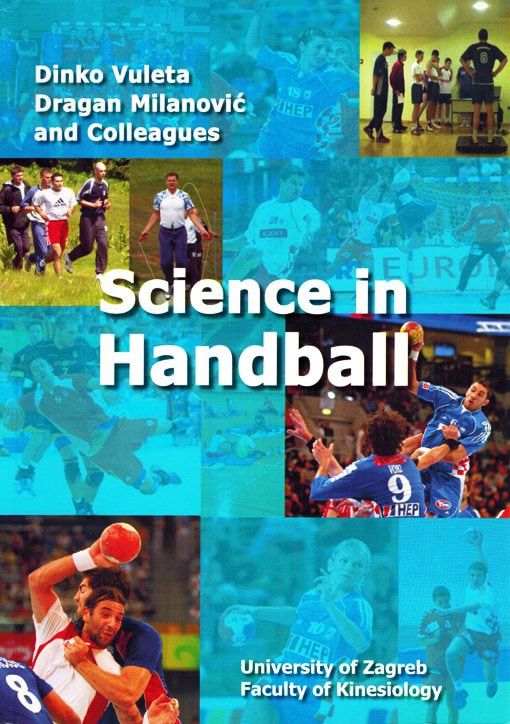Descrição
This book of scientific articles is published during the 21st Men,s Handball World Championship held in Croatia.
We are hoping Croatian national team will be successful as many times before in the last decade, or even two. A question arises: What is the place of kinesiology (or sports sciences) research studies, findings and notions in sports achievements in general, handball in particular?
There is no doubt that nowadays top-level achievements are realized by talented athletes, associated in homogeneous teams, mostly due to high quality training processes managed by expert coaches who get all possible material, organizational and scientific support. Numerous analyses indicate that the highest sports achievements are unimaginable without the application of scientific findings and inferences.
The mentioned facts motivated the editors and authors of this book to collect typical original scientific papers, already published in scientific journals or proceedings, that investigate the game of handball and offer them to academic and professional community, thus overriding limited accessibility of specialised scientific publications to wider expert population.
The book is a systematization and display of research work on handball in Croatia and Slovenia. We are quite aware that our selection is far from being comprehensive, but certain things must be left for the future. Still, it is our hope that the presented papers will be enough for the image of the research possibilities in handball, and more important, of the applicability of scientific findings in improvements of handball training theory and methods.
ÍNDICE
Introduction
1. ANALYSIS OF SPORTING ACTIVITY (RESEARCH STUDIES OF STRUCTURAL BIOMECHANICAL AND TECHNICAL-TACTICAL GAME CHARACTERISTICS AND PERFORMANCE/SITUATION-RELATED EFFICIENCY INDICATORS
1.1. Latent structure of the spatial, phasic, positional and movement characteristics of the handball game
1.2. Differences between technical-tactical elements in handball and the variables affecting success in a handball game
1.3. Position-related differences in volume and intensity of large-scale cyclic movements of male players in handball
1.4. Jump shot performance in team handball- a kinematic model evaluated on the basis of expert modeling
1.5. Kinematic analysis of Ales Pajovic jump shot technique
1.6. Differences in situation-related indicators of the handball game in relation to the achieved competitive results of teams at 1999 World Championship in Egypt
1.7. Differences between situation efficiency models of male handball teams at the World Championship in Tunisia in 2005
1.8. The predictive value of variables for the evaluation of technical-tactical elements in handball
2. ANALYSIS OF DIMENSIONS RESPONSIBLE FOR READINESS AND PHYSICAL FITNESS (RESEARCH STUDIES OF BASIC AND SPECIFIC ANTHROPOLOGICAL CHARACTERISTICS)
2.1. Measurement and evaluation of fitness characteristics of Croatian handball players
2.2. Latent structure of the tests assessing specific motor abilities in the Faculty of Kinesiology students
2.3. Position specific morphological characteristics of top-level male handball players
2.4. Comparison of physical conditioning status of the first and second league male handball players
2.5. Comparison of conditioning status of two Croatian elite male handball players
2.6. Some anthropologic characteristics of elite female handball players at different playing situations
2.7. Differences between competitively efficient and less efficient junior handball players according to their personality traits
2.8. Psychodiagnostics in the function of psycho-social status assessment of female players of one handball team
3. ANALYSIS OF PERFORMANCE INDICATORS (RESEARCH STUDIES OF THE RELATIONS BETWEEN INDICATORS OF PHYSICAL FITNESS, TECHNICAL-TACTICAL PROFICIENCY AND PERFORMANCE)
3.1. The canonical correlation between the mechanism for energy regulation and situation-related efficiency in handball
3.2. Relations among variables of shooting for a goal and outcomes of the 2000 Men,s European Handball Championship matches
3.3. Influence of the goals scored on final outcomes of matches of the 2003 World Handball Championships for men in Portugal
3.4. Performance indicators of teams at the 2003 World Handball Championship in Portugal
3.5. Performance indicators of teams at the 2003 World Handball Championship for women in Croatia
3.6. Influence of the attack end conduction on match result in handball
3.7. Relations between indicators of basic motor abilities and results of goal throwing accuracy tests
4. ANALYSIS OF TRAINING EFFECTS (RESEARCH STUDIES OF CHANGES IN BASIC AND SPECIFIC ANTHROPOLOGICAL STATUS INDICATORS INDUCED BY TRAINING PROGRAMMES CONDUCTED IN DIFFERENT CYCLES OF SPORTS PREPARATION)
4.1. Changes in physical conditioning status of female handball players during the preparation period
4.2. Changes of anthropological attributes in senior male handball players induced by training
4.3. Top-level female handball players, preparedness control in a part of the annual training cycle
4.4. Influence of mini handball on the indicators of basic and specific motor abilities of younger school age girls
4.5. Influence of a training programme on changes in certain motor abilities of female handball cadet players
Sources of contributions
Sponsors

